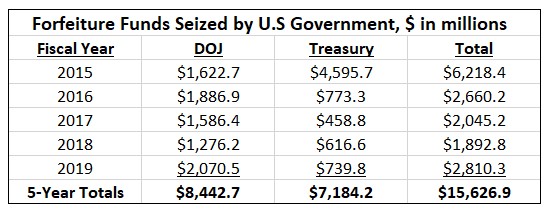
There are many forms of legitimized stealing. The government has perfected a near-perfect version, with motorists too often serving as easy prey.
The NMA’s legislative focus in Washington, even when lawmakers are advancing little during these pandemic times, continues to be two areas of policing-for-profit that desperately need reform. One practice ─ as if it takes much practice to execute ─ is the use of ticket quotas to incentivize the citing and fining of drivers. Just the mention of “ticket quotas” evokes a visceral reaction by motorists everywhere.
But it is the other NMA lobbying focal point in D.C. that serves as the subject of this newsletter. Civil asset forfeiture, while less understood than ticket quotas by most, is a far more lucrative and insidious means by which enforcement agencies profit by seizing property from citizens.
The amount of federal forfeiture funds taken from the populace each year is staggering, with so much to go around that U.S. Department of Justice and the Treasury Department maintain their respective forfeiture trust funds. The following data only detail federal seizures. State enforcement agencies have their own “successful” forfeiture programs.

That’s a cool $15.6 billion in property taken from folks who often were not even charged with committing a crime, let alone convicted. Going back to 2001, when government forfeiture came into vogue, the feds have snatched $44.4 billion worth of assets from the people.
Motorists are particularly vulnerable to seizures at roadway checkpoints and during traffic stops. The justification is crime-fighting, stopping the transport of assets alleged as connected to illegal activities. “Alleged” is usually a term that favors the accused in the American system of justice. However, with civil asset forfeiture, that designation provides the legal basis for the government to seize property without due process.
If you don’t think asset forfeiture can happen to you while out on the open roads, you might want to read the ordeal faced by Phil Parhamovich as described in the cover story of the Winter 2018 issue of Driving Freedoms.
The Institute for Justice released an illuminating study on this issue last June, “Fighting Crime or Raising Revenue, Testing Opposing Views of Forfeiture.” Quoting from the report’s conclusion:
“The results of this study question forfeiture proponents’ claims that forfeiture ─ or at least equitable sharing, the nation’s largest forfeiture program ─ fights crime effectively. At the same time, the results add to the small but growing body of scholarly evidence suggesting the ability to generate revenue is a significant motivator of police forfeiture activity, lending weight to critics’ claims that law enforcement agencies use forfeiture to police for profit.”
“As it stands, the weight of the scholarly evidence supports forfeiture critics. Given the serious civil liberties concerns raised by forfeiture, and especially civil forfeiture, the onus should be on forfeiture proponents to provide systematic, empirical evidence for their claims that forfeiture is a crucial law enforcement tool.”
The good news is that several federal lawmakers, and advocates like Institute for Justice, are joining the NMA in a push to overhaul forfeiture laws. Due process and agency transparency must become synonymous with civil asset forfeiture. While the coronavirus crisis has held up progress in Congress for the past few months, we are poised to apply new pressure so that forfeiture reform is given priority, perhaps as part of a much-needed transportation and infrastructure bill that legislators must act on soon.



